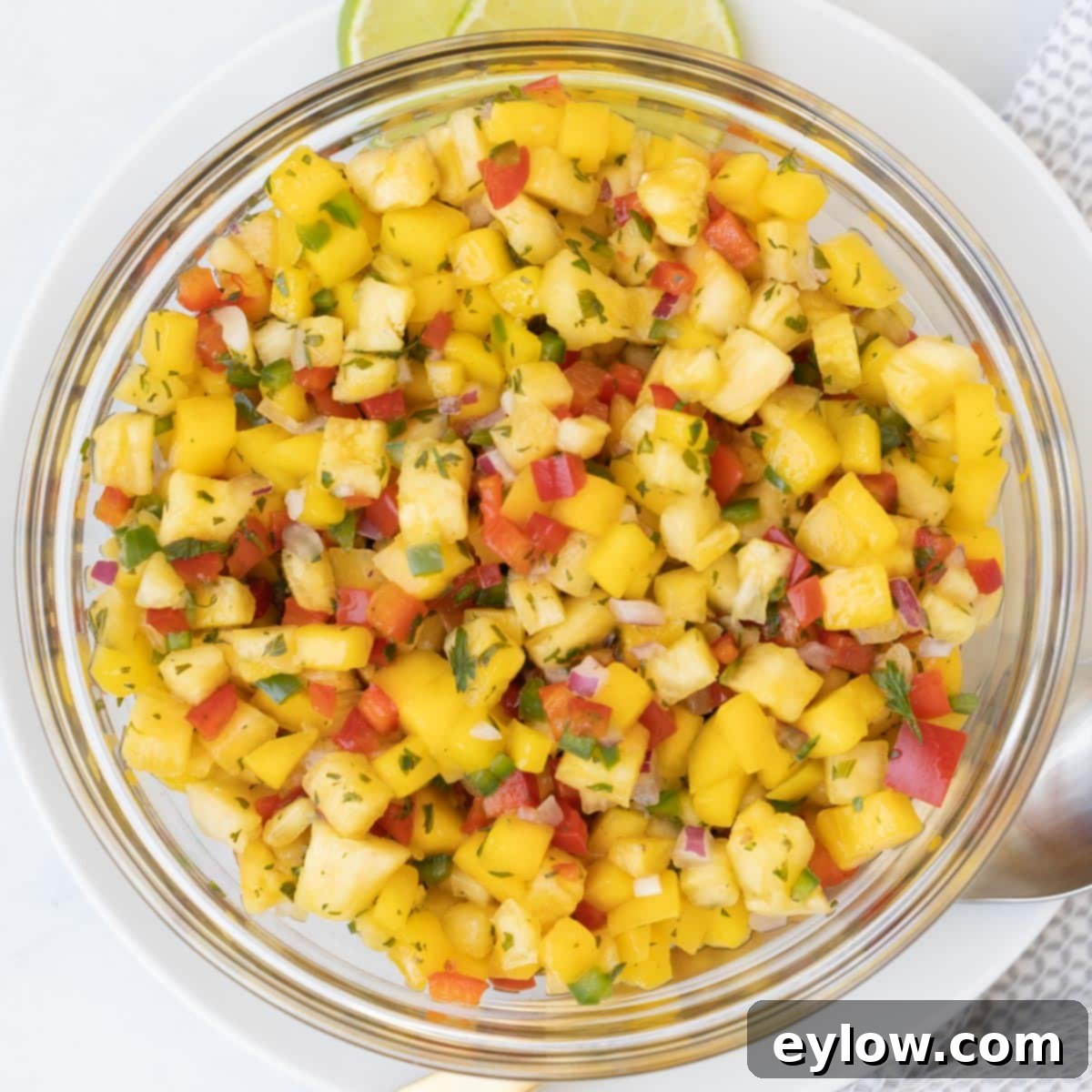Tropical Pineapple Mango Salsa Recipe: Your Guide to a Refreshing Summer Flavor
Infuse your summer with the vibrant, sweet, and tangy flavors of homemade pineapple mango salsa. This refreshing fruit salsa isn’t just a side dish; it’s a versatile condiment that elevates everything from your favorite grilled seafood and chicken to succulent pork tenderloin and even simple tacos. Easy to prepare and bursting with sunshine, it’s destined to become your go-to summer staple for bright, healthy meals.
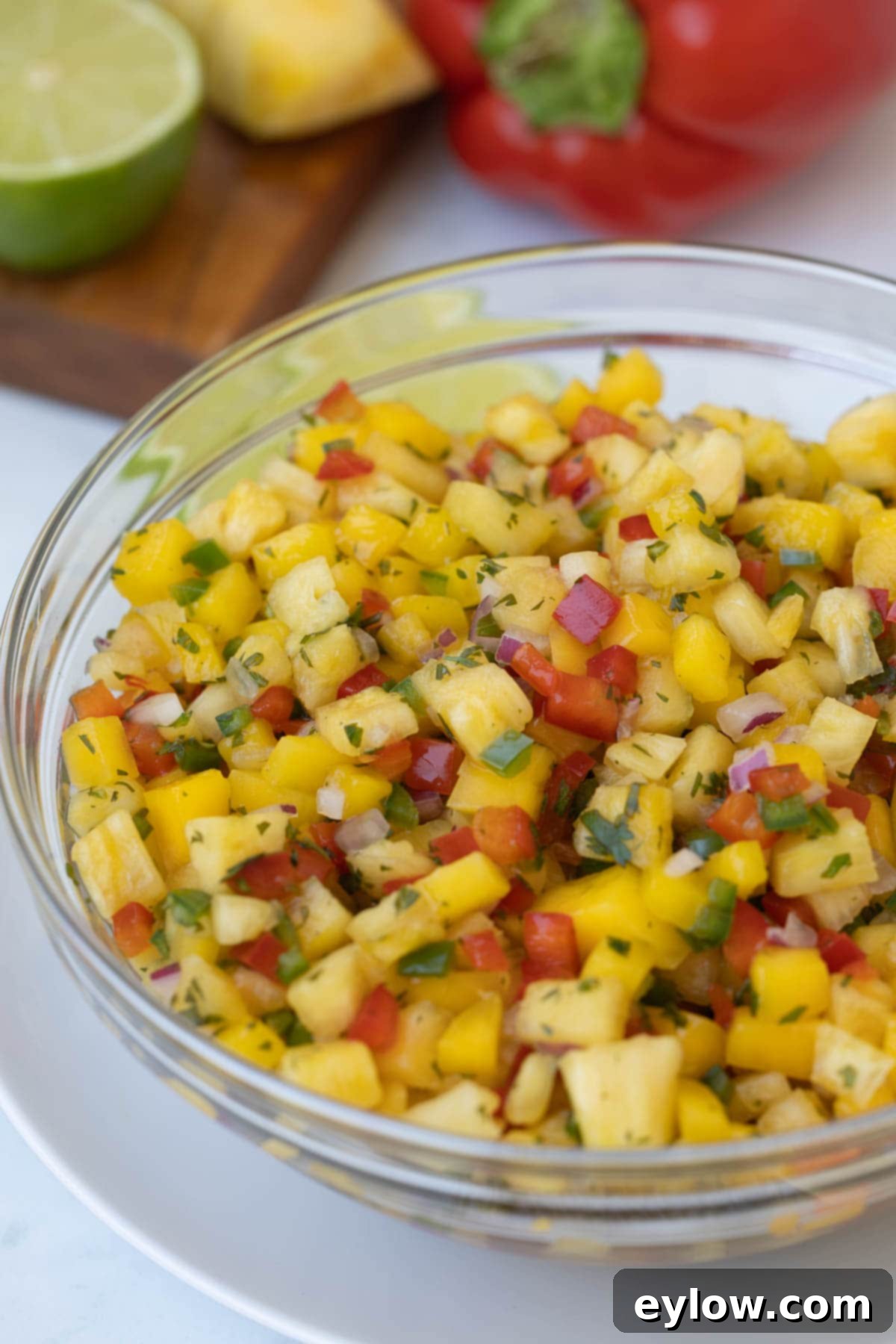
This tropical fruit salsa proved to be an absolute sensation in a recent cooking class I taught, and its undeniable appeal made it clear I had to share this simple yet spectacular recipe with you. Capitalize on the abundance of peak-season summer produce to whip up a batch of this incredibly easy pineapple mango salsa. Its dazzling colors and dynamic flavors are truly exceptional, making it a feast for both the eyes and the palate. Not only is it delicious, but it’s also a fantastic way to add healthy, whole ingredients to your meals, ensuring your summer dining is as nutritious as it is tasty.
Why You’ll Love This Tropical Pineapple Mango Salsa Recipe
There are countless reasons why this homemade pineapple mango salsa will become a favorite in your kitchen, especially during the warmer months. It’s a culinary delight that ticks all the boxes for a perfect summer dish:
- Unbeatably Fresh, Flavorful, and Versatile: This isn’t just a condiment; it’s a flavor explosion. Made with fresh, ripe fruits and crisp vegetables, every bite offers a burst of sweet, savory, and tangy notes. Its versatility means it pairs beautifully with an impressive array of dishes, from delicate seafood to robust meats, making it an indispensable part of your summer menu.
- No Cooking Required – Perfect for Hot Summer Days: Forget heating up your kitchen! This salsa comes together entirely without cooking, making it an ideal recipe for those sweltering summer days when you want something light, cool, and effortless. It’s a refreshing break from heavy cooked meals.
- A Unique Fruit-Based Pico de Gallo: Think of it as a delightful, tropical twist on the classic pico de gallo. While traditional pico relies on tomatoes, this recipe substitutes them with juicy pineapple and sweet mango, creating a vibrant, fruity alternative that’s equally invigorating and much more exotic.
- Harmonious Sweet and Savory Combination: The magic of this salsa lies in its perfect balance. The natural sweetness of pineapple and mango is expertly complemented by the savory kick of red onion, the subtle heat of jalapeño, and the bright acidity of lime. This exquisite interplay of flavors makes it incredibly addictive.
- Packed with Nutrients: Beyond its delicious taste, this salsa is a powerhouse of nutrition. Pineapple and mango are rich in vitamins, minerals, and antioxidants, offering a healthy boost with every spoonful.
For another cool and refreshing summer favorite, be sure to try this homemade tomato summer gazpacho, a perfect partner for sunny days.
Essential Ingredients for Pineapple Mango Salsa
Crafting the perfect pineapple mango salsa begins with selecting the freshest, highest-quality ingredients. Each component plays a crucial role in building the layered flavors and textures that make this salsa so extraordinary. Here’s a closer look at what you’ll need and why:
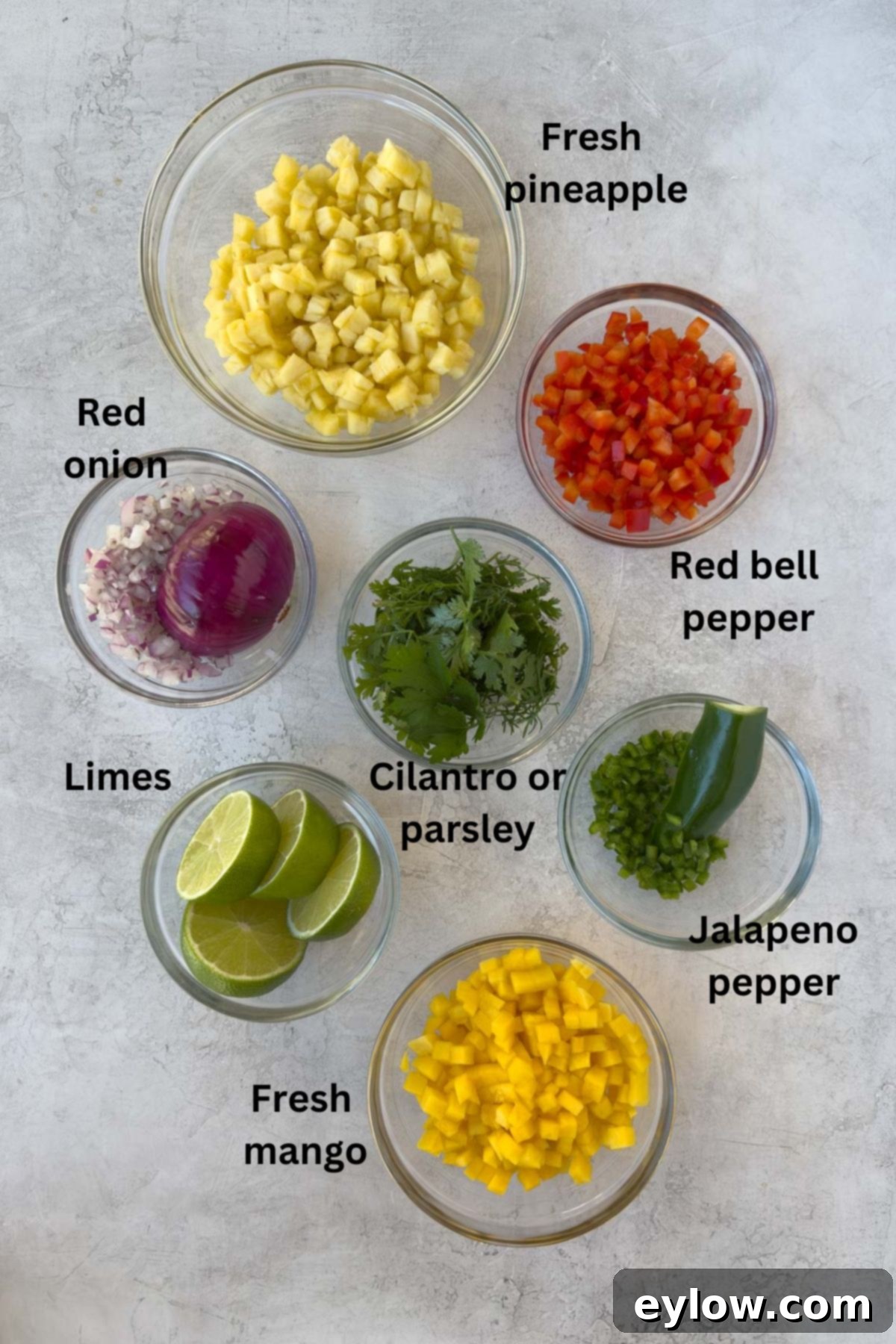
- Pineapple: You’ll need about half of a small (approximately 3-pound) fresh, ripe pineapple. Fresh pineapple provides the best flavor and texture, offering a sweet-tart juiciness that’s central to the salsa. If fresh isn’t an option or you’re short on time, pre-cut fruit spears from the produce section can be a convenient alternative. Opt for spears over chunks if available, as they often have a better texture.
- Mango: Select one ripe, sweet mango. The key is to find one that yields slightly to gentle pressure and has a fragrant, tropical aroma. Avoid overly soft mangoes, as they can become mushy when diced; you want it firm enough to hold its shape for a pleasing bite.
- Red Onion: Finely chopped red onion adds a beautiful pop of color and a crucial savory, pungent counterpoint to the sweetness of the fruit. Its crisp texture also contributes to the overall freshness. While red onion is preferred, other sweet onions or even a finely minced shallot can work in a pinch.
- Green Pepper (Jalapeño): For a touch of lively heat, a finely diced jalapeño pepper is ideal. You can adjust the spice level by removing the seeds and membranes (where most of the heat resides) for a milder salsa, or leaving some in for more kick.
- Red Bell Pepper: The addition of finely chopped red bell pepper brings both a subtle sweetness and a stunning color contrast, enhancing the visual appeal of the salsa. An orange bell pepper is a good substitute if red isn’t available.
- Fresh Herbs: A generous handful of fresh cilantro and mint leaves creates a truly exceptional aromatic profile. Their bright, herbaceous notes perfectly complement the tropical fruits. Flat-leaf parsley can be used as an alternative to cilantro if preferred.
- Lime Juice: Freshly squeezed lime juice is non-negotiable! It provides essential bright, refreshing acidity that cuts through the sweetness of the fruit, balancing the flavors and preventing the salsa from tasting overly sweet. It also helps to preserve the freshness of the fruits.
- Sea Salt: Just a pinch of sea salt enhances all the other flavors, bringing them into harmony.
For precise quantities and measurements, please refer to the detailed recipe card provided below.
Chef’s Tip: How to Select a Ripe Mango. While numerous mango varieties exist globally, those commonly found in grocery stores, particularly in regions like Southern California, are typically oval-shaped and often display a mix of green, yellow, and orange hues when ripe. A perfect ripe mango should yield slightly to soft, gentle pressure when squeezed and emit a distinctly sweet, fruity aroma near its stem. If a mango feels rock-hard, it’s not yet ready to be enjoyed and will need a few days to ripen at room temperature.
Exciting Substitutions and Variations for Your Salsa
One of the best aspects of making homemade salsa is the freedom to customize it to your taste. Don’t be afraid to experiment with these simple substitutions and additions to make your pineapple mango salsa truly your own. You asked about variations, and I’m happy to provide some creative ideas:
- For More Heat: If you crave a spicier kick, consider swapping the jalapeño for a hotter red or green pepper, such as a serrano pepper. A tiny amount of finely minced habanero or a dash of your favorite hot sauce can also dial up the intensity significantly.
- For Mild Salsa: If you prefer a gentle flavor profile with no heat, simply omit the jalapeño entirely. Alternatively, replace it with a finely diced green bell pepper or a mild Anaheim pepper, which will add a fresh, crisp texture without the spice.
- For Extra Green Color and Flavor: Enhance the visual appeal and add subtle herbaceous notes by incorporating finely chopped chives or additional fresh herbs like extra cilantro or parsley. Finely sliced green onion (scallions) can also offer a mild oniony freshness.
- No Fresh Pineapple? No Problem! While fresh pineapple offers the best texture and flavor, you can certainly use canned pineapple as a convenient substitute. Just be sure to choose canned pineapple packed in water, not syrup, to avoid excessive sweetness. Drain it thoroughly before chopping and adding to the salsa.
- Craving a Pure Mango Salsa? If mango is your absolute favorite, you can easily adapt this recipe. Simply omit the pineapple and increase the mango to about three medium-sized, ripe fruits. The result will be a beautifully rich and sweet mango-focused salsa that’s equally delicious.
- Add Creaminess with Avocado: For a richer, more substantial salsa, gently fold in one diced ripe avocado just before serving. Its creamy texture and mild flavor perfectly complement the fruit.
- A Zesty Hint of Ginger: A tiny bit of freshly grated ginger (about ½ teaspoon) can add an unexpected and delightful zing to your tropical salsa.
- Make it a Pineapple Mango Corn Salsa: For added texture and sweetness, especially if fresh corn is in season, consider adding about ½ cup of fresh or thawed frozen corn kernels.
If you’re a fan of diverse salsas, you might also enjoy this homemade salsa verde recipe, made with tangy tomatillos, or perhaps this intriguing sweet and spicy strawberry salsa for another fruity adventure.
Simple Recipe Instructions for Assembling Your Salsa
Once you’ve prepared your fresh pineapple and mango, assembling this vibrant salsa is incredibly quick and easy. The beauty of this recipe lies in its simplicity and the fresh taste of its ingredients.
- Begin by combining the uniformly chopped pineapple and mango in a large mixing bowl.
- Next, add the finely chopped red onion, red bell pepper, and jalapeño pepper to the bowl.
- Gently toss all the ingredients together to ensure they are well mixed.
- Pour in the fresh lime juice, and sprinkle with your chosen fresh herbs (cilantro and/or mint) and a pinch of sea salt.
- Toss again until everything is evenly coated.
- Cover the bowl and place it in the refrigerator to chill for at least 30 minutes. This chilling time is essential, as it allows the flavors to meld beautifully and intensify, resulting in a more harmonious and refreshing salsa.
Your cooling summer pineapple mango salsa is now ready to serve! If you’re new to cutting fresh pineapple and mango, don’t worry – detailed instructions and helpful visuals follow.

Mastering the Art of Cutting a Fresh Pineapple
If you’ve ever felt intimidated by cutting a fresh pineapple, rest assured, it’s simpler than you might think. I’ve personally cut through countless cases of pineapples for large catering events, so I can share a foolproof method for preparing this delicious fruit. This technique is perfect for creating spears or chunks for fruit platters, or for dicing into smaller pieces specifically for this pineapple mango salsa. Note that cutting pineapple into rings involves a slightly different approach.
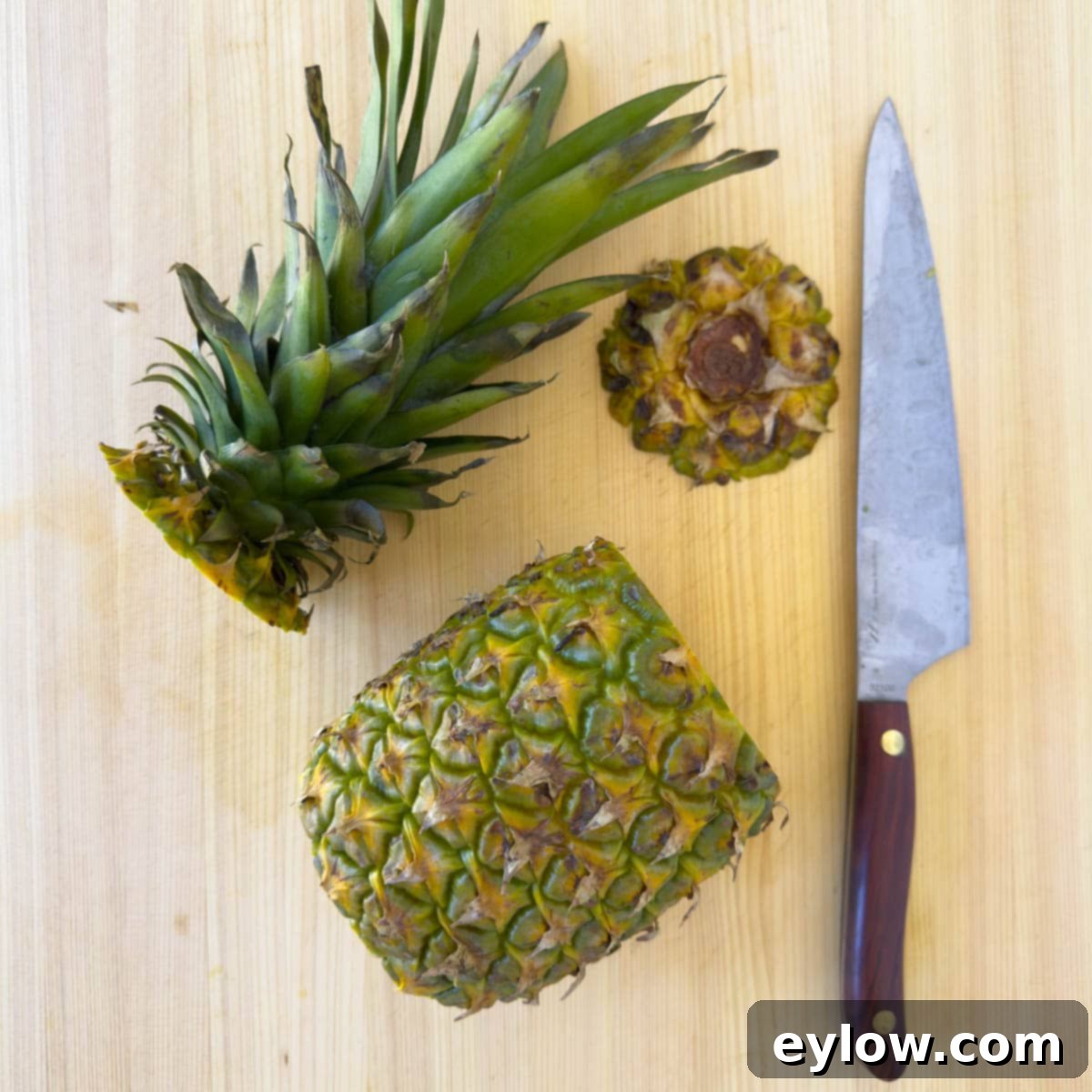
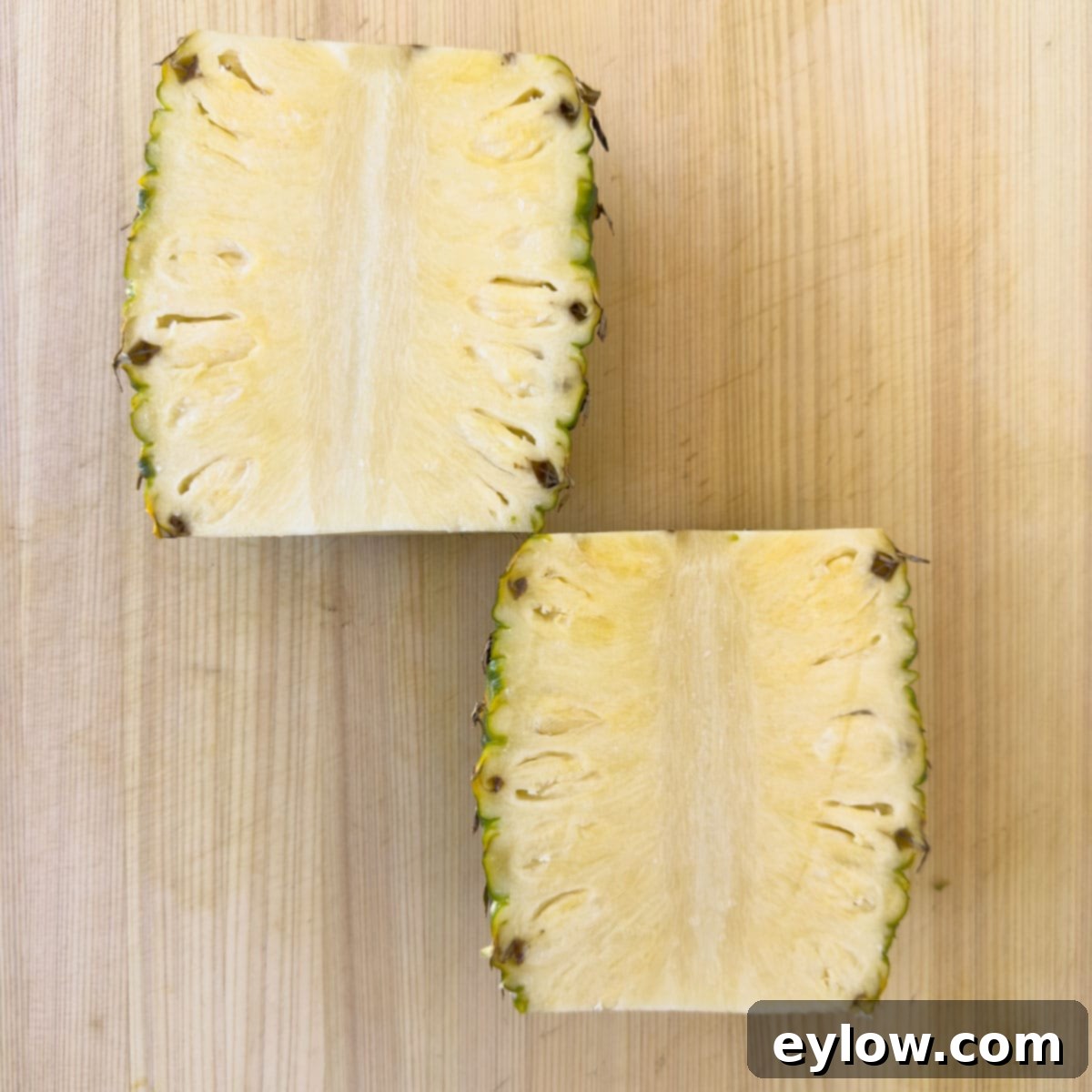
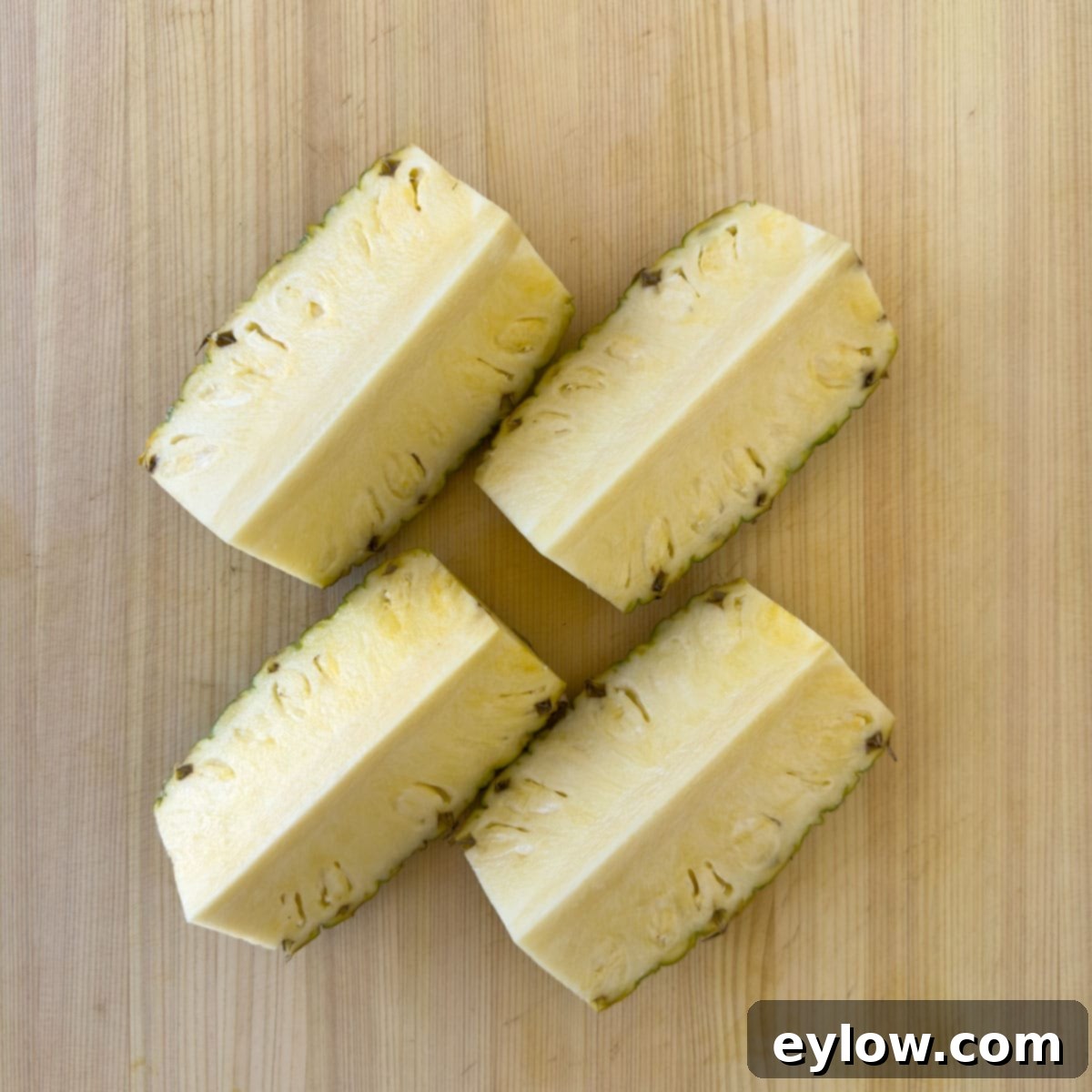


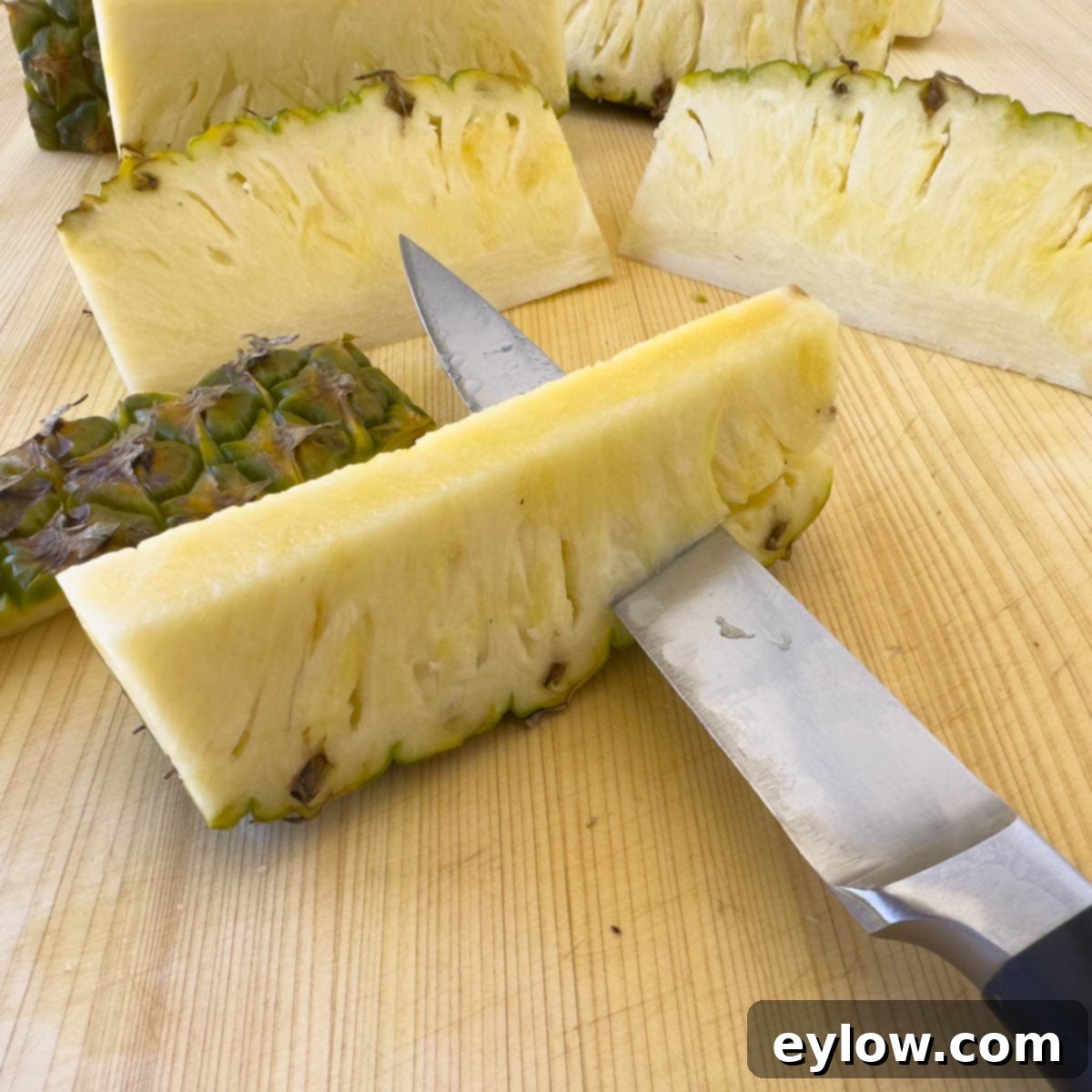


Chef’s Tip: How to Choose a Perfectly Ripe Pineapple. A truly ripe pineapple will lose its greenish hue and develop a beautiful golden yellow color on its skin. It should emit a distinctly sweet and tropical fragrance from its base. When gently squeezed, it should yield slightly to soft pressure, not feel rock-hard. A simple test for ripeness is to gently tug on one of the inner leaves from the crown; if it comes out easily, your pineapple is likely ready to enjoy.
Effortlessly Cutting Up a Fresh Mango for Salsa
Preparing a fresh mango for salsa requires a specific technique to ensure you get clean, small pieces without dealing with its large, flat pit. While there are several methods, here’s the one I find most efficient for a finely diced fruit salsa. This method allows for smaller, more uniform pieces, which are ideal for a delicate salsa texture rather than a chunky fruit salad.
- First, carefully peel the mango using a sharp vegetable peeler. An inexpensive plastic Y-peeler often works best for navigating the mango’s contours. Trim off the very bottom of the mango to create a flat base.
- Stand the peeled mango upright on your cutting board on its newly flattened end. Mangos have a large, flat, oval-shaped pit in their center. You want to slice around it.
- Starting with the wider side of the mango, make a cut about ½ to ¾ inch away from the center, slicing down through the flesh to remove one large “cheek” of mango. Rotate the mango and repeat on the other wide side to remove the second “cheek.”
- Next, carefully trim any remaining flesh from the narrower sides and around the pit.
- Once you have all the mango flesh separated from the pit, dice it into small, uniform pieces, aiming for a size similar to your chopped pineapple. Discard the large, flat pit.
Why this method? This approach allows you to achieve smaller, more consistent dice compared to the popular “grid” method (where you score the flesh while still in the skin). For a refined salsa, where the fruit is meant to be part of a cohesive mixture, finer pieces integrate better and offer a more pleasant mouthfeel.
Chef’s Tip: Great Mango Substitutes for Salsa. If fresh mango isn’t readily available or if you’re looking for an alternative flavor, several other fruits make excellent substitutes in salsa. Consider replacing mango with finely chopped ripe peaches, sweet nectarines, or even fresh, juicy strawberries. All of these options are wonderfully fruity and will create a delicious, vibrant salsa.
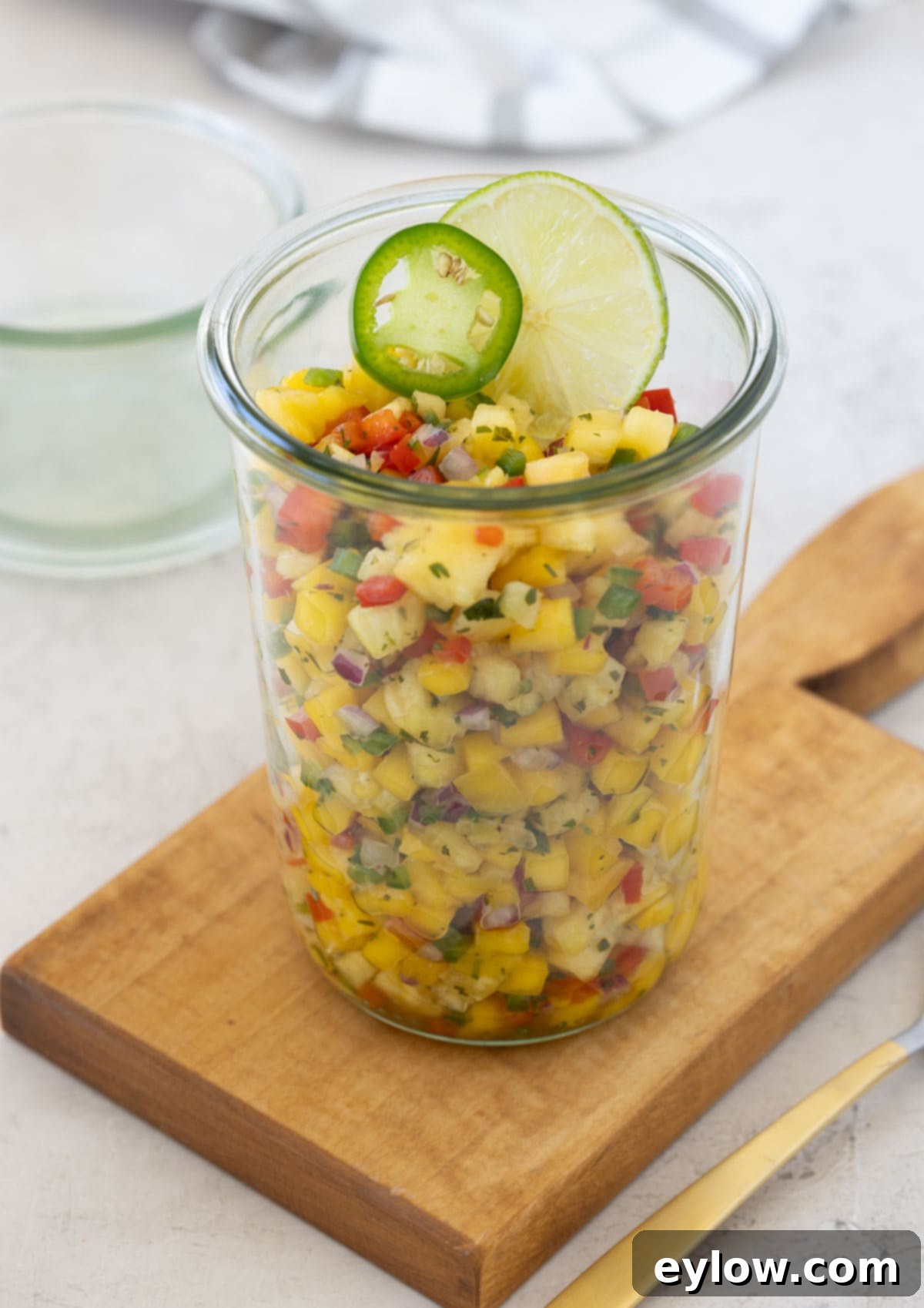
Delightful Serving Suggestions for Pineapple Mango Salsa
This versatile pineapple mango salsa is much more than just a dip; its bright, fresh flavors make it an incredible accompaniment to a wide variety of dishes. As the salsa chills in the refrigerator, the fruits release their juices, making it wonderfully moist. If you find it too juicy for your preference, simply strain off some of the excess liquid before serving.
- Classic Chip Dip: Serve your pineapple mango salsa with crisp tortilla chips, just as you would a traditional red tomato salsa or a tangy green tomatillo salsa. The sweet and savory notes pair perfectly with the salty crunch of the chips.
- Grilled Chicken and Pork: This salsa is an absolute game-changer for grilled meats. Spoon it generously over grilled boneless, skinless chicken breast, tender pork tenderloin, or pork chops. The fresh fruit salsa adds moisture, tang, and a burst of flavor that beautifully complements the smoky char of the grill.
- Seafood Sensation: It’s a match made in heaven for all types of seafood. Try it with stovetop seared salmon, flaky white fish like cod or snapper, or even grilled scallops and shrimp. The tropical flavors enhance the natural sweetness of the seafood without overpowering it.
- Taco Topping Extraordinaire: Elevate any taco night with a dollop of this vibrant salsa. It’s particularly outstanding with grilled shrimp tacos, fish tacos, or even vegetarian black bean tacos, adding a sweet, zesty counterpoint.
- Unexpected Pairings: For a surprisingly delicious and healthy snack or light breakfast, try serving pineapple mango salsa over a bowl of cottage cheese. The combination of creamy, savory cheese with fresh, sweet fruit is truly delightful.
- Brighten Up Rice Bowls: Stir a spoonful or two into your next rice bowl or grain bowl. It instantly adds a burst of freshness, color, and flavor to otherwise simple ingredients.
While leftover pineapple mango salsa can last for 4-5 days when stored in an airtight container in the refrigerator, it’s generally at its best within the first 2-3 days for optimal freshness and flavor. For more detailed information on food storage and safety, consult resources like the FoodKeeper App at FoodSafety.gov.
Pineapple Mango Salsa: Frequently Asked Questions
The core ingredients in this vibrant pineapple mango salsa include fresh, ripe pineapple (or good quality canned pineapple packed in water), sweet fresh mango, finely chopped red onion for a savory bite, red bell pepper for sweetness and color, a jalapeño pepper to provide a touch of heat, bright fresh lime juice, and aromatic fresh herbs such as cilantro or mint leaves. A pinch of sea salt ties all these flavors together. While many variations exist, these ingredients form the delicious foundation of a classic tropical pineapple mango salsa.
Beyond the absolutely fantastic combination of flavors, eating pineapple and mango together offers numerous health benefits. Scientifically, these tropical fruits share similar aroma compounds, which explains why their flavors blend so harmoniously. Both pineapple and mango are exceptionally rich in essential vitamins, particularly high in Vitamin C, vital minerals, and powerful antioxidants. Pineapple also provides bromelain, an enzyme known for its anti-inflammatory properties. Their bright, vivid colors are indicators of beta-carotene, another beneficial antioxidant. Combining these fruits is a delicious and potent way to boost your intake of healthful nutrients, contributing positively to your overall well-being and adding a vibrant touch to your diet.
Absolutely, pineapple mango salsa is a very healthy choice, especially when prepared at home. Making it yourself gives you complete control over the ingredients, ensuring no unnecessary added sugars, preservatives, or artificial flavors. This fresh fruit salsa is packed with an abundance of vitamins, including significant amounts of Vitamin C, a variety of beneficial minerals, powerful antioxidants, and a good dose of dietary fiber. The sweetness comes purely from nature’s natural sugars found in the fruits themselves. For store-bought versions, always remember to check the nutritional labels for any added sugars or artificial additives.
Pineapple mango salsa is not considered a traditional Mexican salsa, which typically features tomatoes as its base alongside chili peppers, onion, and cilantro. However, it certainly shares some fundamental flavor profiles and a refreshing, zesty character with Mexican cuisine. It’s more accurately described as a modern, tropical fruit salsa that draws inspiration from traditional salsa concepts but offers a unique and delicious sweet-savory twist. While not traditional, its incredible taste and versatility have made it a widely loved condiment.
While you can technically freeze pineapple mango salsa, its texture will change significantly upon thawing. The fruits, particularly the mango, will become much softer and lose some of their crispness due to the water content crystallizing and breaking down cell walls. It would still be suitable for use in smoothies, marinades, or cooked applications where texture is less critical, but it’s not recommended for serving as a fresh salsa with chips or as a topping where a firm texture is desired.
Explore More Fresh & Healthy Recipes
If you’ve enjoyed the fresh flavors of this tropical salsa, you’re sure to love these other wholesome and delicious recipes. They’re perfect for keeping your meals light, flavorful, and healthy.
Consider pairing this salsa with grilled lemon mint chicken for a complete and utterly satisfying summer meal. And if your love for mango knows no bounds, kickstart your day with my invigorating spiced coconut mango smoothie for a tropical breakfast treat.
- Sweet Corn Succotash with Bacon
- How to Make Mexican Watermelon Water (Agua Fresca)
- Summer Watermelon Goat Cheese Appetizer
- Cucumber and Dill Salad with Feta
⭐️ Did You Make This Recipe?
If you’ve tried your hand at making this delightful pineapple mango salsa, I would absolutely love to hear about your experience! Please share your thoughts and comments below. Your feedback helps me improve and inspires other readers. If you loved it and found it to be a fantastic addition to your summer menu, please consider giving it a 5-star rating! Your ratings are incredibly helpful to others seeking delicious recipes.
📖 Recipe

Pineapple Mango Salsa
Sally Cameron
Prevent your screen from going dark
Pin Recipe
20 minutes
0 minutes
20 minutes
condiment, Sauce
American, Tropical, Mexican Inspired
6
⅓ cup each
50
kcal
Equipment
-
Chef’s knife -
Cutting board -
Large mixing bowl
Ingredients
-
½
small
fresh ripe pineapple
or 8 ounces pre-cut pineapple spears/chunks -
1
small
ripe fresh mango
(about 6-8 ounces, or pre-cut equivalent) -
2
tablespoons
finely chopped red onion -
1/2
red bell pepper
finely chopped -
1
jalapeño
seeded and finely chopped (adjust to taste for heat) -
2
limes
freshly juiced (about 2-3 tablespoons) -
1-2
tablespoons
fresh chopped cilantro or mint leaves
(or a mix, or flat-leaf parsley) -
1
pinch
sea salt
(or to taste)
Instructions
If starting with a whole pineapple:
-
Refer to the detailed photos and instructions in the post above for visual guidance on how to cut a pineapple. With a sharp, heavy chef’s knife, carefully slice off the top crown and the bottom base of the pineapple. Stand the pineapple upright on one of its flat ends on a stable cutting board and cut it in half vertically from top to bottom. You will use half of the pineapple for this salsa recipe and can save the other half for another use, such as freezing for smoothies or grilling for dessert.
Next, take one of the pineapple halves and cut it in half again lengthwise, creating two long quarter wedges. Lay each wedge flat on its side and, using your knife, trim out the tough, fibrous inner core. Then, place the wedge rind-side down and carefully run a thin, sharp knife close to the rind, cutting away the flesh. Take these long pineapple strips and slice them again into several thinner strips, then dice them into small, uniform pieces. Place the diced pineapple into a medium mixing bowl.
If starting with pre-cut pineapple:
-
Chop the pre-cut pineapple (whether spears or chunks) into small, even cubes or pieces, roughly ¼ to ½ inch in size. Add these diced pieces to your medium mixing bowl.
How to cut up a mango:
-
First, peel the mango entirely with a sharp vegetable peeler. Trim off a small portion from the bottom to create a stable, flat base. Stand the mango upright on your cutting board. Carefully slice off two large “cheeks” of mango flesh from the wide, oval sides, cutting around the large central pit. Then, trim any additional mango flesh from the narrower sides and around the pit. Dice all the mango flesh into small, uniform cubes, aiming for a size similar to your pineapple pieces. Add the diced mango to the bowl with the pineapple. Discard the large oval pit.
Note: While some methods involve scoring the mango flesh in its skin, this peeling and dicing method allows for much finer chopped mango, resulting in a more refined salsa texture rather than a chunky fruit salad consistency.
Finish the salsa:
-
To the bowl containing the pineapple and mango, add the finely chopped red onion, red bell pepper, and jalapeño. Gently toss all the ingredients together to combine. Pour in the fresh lime juice, sprinkle with your desired fresh herbs (cilantro, mint, or parsley), and add a pinch of sea salt. Toss once more to ensure everything is evenly coated. Taste the salsa and make any personal adjustments to the seasoning or lime juice as preferred. For best flavor, cover and chill in the refrigerator for at least 30 minutes before serving, allowing the flavors to meld beautifully.
Notes
Substitutions & Variations:
For more heat, you can use a hotter pepper such as a serrano pepper instead of (or in addition to) the jalapeño. Remember to adjust quantities based on your heat tolerance.
For a mild salsa, simply omit the jalapeño or replace it with a finely diced green bell pepper or a mild Anaheim pepper for flavor without the spice.
No fresh pineapple? Canned pineapple is a viable alternative. Ensure you select pineapple packed in water, not heavy syrup, and drain it thoroughly before chopping. You’ll need about 6-8 ounces after draining.
No fresh mango? Chopped peaches, nectarines, or even strawberries can be delightful substitutes, offering a similar sweet and juicy texture.
Nutrition
Serving:
0.333
cup
Calories:
50
kcal
Carbohydrates:
13
g
Protein:
1
g
Fat:
0.3
g
Saturated Fat:
0.1
g
Polyunsaturated Fat:
0.1
g
Monounsaturated Fat:
0.1
g
Sodium:
9
mg
Potassium:
165
mg
Fiber:
2
g
Sugar:
9
g
Vitamin A:
997
IU
Vitamin C:
63
mg
Calcium:
18
mg
Iron:
0.4
mg
Tried this recipe?
Let us know how it was with a comment and leave a star rating!
